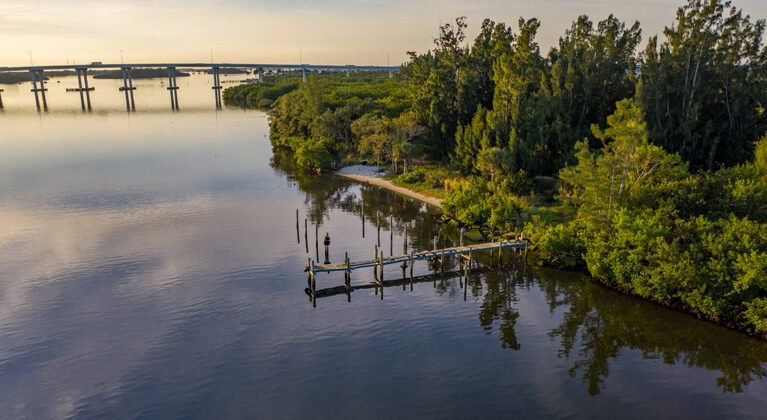
All island residents who care about protecting the wide green vista along the western shore of the lagoon that we see when coming over the top of the Barber Bridge got a late Christmas present last week from the Indian River Land Trust.
The nonprofit, which was founded in 1990 to help save McKee Botanical Gardens, scored its biggest triumph in recent years on Friday, when it closed on the purchase of a 65-acre parcel just north of the Barber Bridge.
The land, long known as the Hoffmann property, completes what is now a two-mile stretch of shoreline – extending from the main relief canal south of the bridge to Oak Harbor – that will be preserved in its natural state for the foreseeable future.
“This is the most visible and impactful acquisition we have made along the lagoon,” Land Trust board chairman Chuck Cramb said. “The property embodies the Land Trust’s . . . [goal of] preserving habitat, protecting scenic waterfront and providing public access to the benefit of future generations.”
The importance of the purchase was heightened because “the land was poised for development,” according to Land Trust executive director Ken Grudens. “The owners gave up some of their land when Indian River Boulevard was built and as part of their deal with the county, the county built a road and a substantial bridge providing access to the property that would make it easy to develop the upland portion.
“If that pivotal parcel had been developed for commercial or residential use, it would have changed the character of the shoreline forever and detracted from the sense of Vero Beach as an oasis that people want to preserve,” Grudens said.
The property was owned for many years by Paul and Camille Hoffmann, prominent residential developers and world-renowned art collectors from Illinois who later moved to Stuart.
After Paul Hoffmann died in 1998, Camille Hoffmann maintained ownership of the land.
Grudens says the Land Trust began talking with Camille Hoffmann about buying the property in 2010, “as soon as we turned our attention to preserving the lagoon shoreline,” but the conversations petered out.
When Camille Hoffman passed away in Stuart at the age of 90 in 2017, the Land Trust restarted talks about buying the property with one of the Hoffmanns’ granddaughters who was named executor of the estate.
“She was really excited about the idea of the land being put into conversation,” says Ann Taylor, the Land Trust’s director of marketing and philanthropy.
Despite that excitement, talks dragged out for two and a half years – mainly due to the complexity of settling the far-flung Hoffmann estate – until last week, when the deal finally went through, rewarding a decade of patience and persistence by the Land Trust.
On Friday, the nonprofit organization closed on 100 acres of land owned by the Hoffmann estate – the key 65-acre parcel north of the bridge and another 35 acres of prime waterfront land south of the Fairlane Harbor mobile home community – paying a total of $3 million for the two parcels.
With the purchase, the Land Trust now owns 300 contiguous acres north of the Barber Bridge – the entire shoreline from the southern edge of the Hoffmann property up to 45th Street, just south of Oak Harbor, except for two small parcels totaling three quarters of an acre.
South of the Hoffman property, the green belt is extended by 114 acres of county-owned land that flanks the Barber Bridge. County officials say that while that tract is not officially designated as conservation land – which would require creating a conservation management and maintenance plan – the county has no plans to develop it.
All but nine of the 114 acres are wetlands, which would make it nearly impossible to develop in the current permitting environment even if there was a desire to build something, according to the county Community Development Department.
Purchase of the Hoffmann parcels comes on top of another substantial acquisition by the Land Trust. On Dec. 31 the nonprofit closed on a 30-acre track near Wabasso that stretches from U.S. 1 to the Indian River Lagoon, with a quarter mile of water frontage.
The Indian River Land Trust was founded in 1990 to help save McKee Botanical Gardens, a 10-year, $10-million project. Following that successful effort, the Trust was instrumental in preserving 2,000 acres of agricultural land from development.
In 2004, it led the effort to pass a $50-million land and water protection bond issue referendum that was approved by 67 percent of voters, enabling the county to purchase properties for conservation.
When the real estate recession hit in 2008, and land prices crashed, the group turned its attention to buying acreage along the lagoon.
Since that time, the Land Trust has acquired nearly 1,200 acres and 12 miles of lagoon shoreline for conservation purposes, including the keystone purchase of the Hoffmann property last week.
Taylor said the Hoffmann purchase would not have been possible without the help of real estate attorney Michael O’Haire, a Land Trust director emeritus who helped handle the deal, and certain donors who pledged money specifically for the Hoffmann land.
Camille Hoffmann was a pioneering female attorney in Illinois in the 1950s – the second woman to work in the Illinois State’s Attorney Office, according to her obituary in the Chicago Tribune. She later became a major residential developer in Illinois and was named “one of the top 10 collectors of contemporary art in the 1990s.”
Art Magazine included her and her husband, Paul Hoffmann, who served as chairman of the board of the Chicago Art Institute, on its list of the world’s 200 most important art collectors. The Hoffmanns also were notable philanthropists, donating to museums, hospitals and animal rescue organizations.



